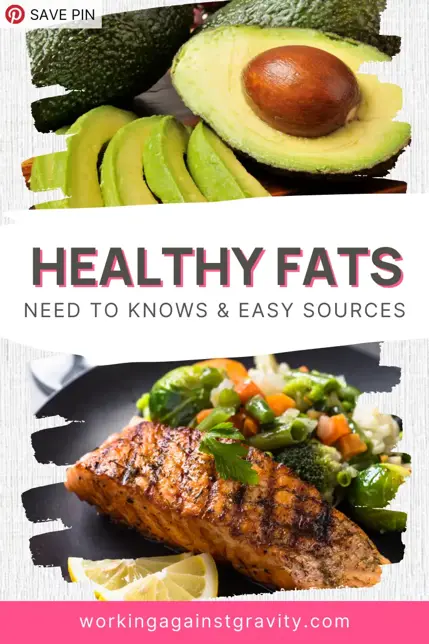
If you’ve spent any time researching the nutrition space, you’ve likely heard the term “healthy fats.” While there are no such things as “good” foods or “bad” foods, there certainly are foods that provide your body with the nutrients it needs to truly thrive—especially when it comes to healthy, sustainable weight loss.

Fat can get a bit of a bad rap, but the truth is fats are essential to the body. They have many positive benefits, including supporting joint health, nutrient absorption, healthy hormones, and digestion. They also keep your nails, hair, and skin looking great!
That said, too much of a good thing is still too much. Because fat is the most calorie-dense of all the macronutrients—9 calories per gram versus the four calories per gram that carbs and protein contain—you need to moderate your daily intake as it can impact training performance and what you see in the mirror.
Types of Healthy Fats
The type of fat you consume impacts your health and weight loss goals. Let’s take a look at the different types and what to consider when adding them to your diet.
Advertisement

Saturated Fats
Saturated fats are most commonly found in animal byproducts. This includes high-fat and processed meat and high-fat dairy products like butter and cheese. Saturated fats can increase the level of LDL in your blood (the “bad” cholesterol) so we recommend eating them in lower quantities and focusing on the unsaturated fats recommended below.
A Quick Note on Trans Fats
Trans fats are man-made fats derived from vegetable oil and should only make up a small percentage of overall daily (or weekly) calories. In the summer of 2023, the World Health Organization updated its guidelines and currently recommends that no more than 1% of total calorie intake should come from trans fats—we suggest the same [1].
Unsaturated Fats
Unsaturated fats generally fall under the category of “good fats.” These include polyunsaturated and monounsaturated fats like nuts, whole eggs, seeds, fish, and olives. These fats can not only increase HDL levels (good cholesterol!) but can also help lower LDL.
Omega-3 Fats vs. Omega-6s Fats
When it comes to healthy fats for weight loss, Omega-3s often take the spotlight. They have a range of positive benefits for the body, including improving joint health and reducing inflammation. But where does that leave omega-6s?
Advertisement

While both fats are essential (meaning that the body does not naturally produce them), most people can benefit from increasing their Omega-3 consumption. The Western diet already contains plenty of Omega-6 fats (found in sunflower, palm, soybean, and canola cooking oils).
Need to increase your Omega-3 consumption? Look to fatty fish like salmon, mackerel, and sardines. Flax and walnuts are also great options! Lastly, fish oil as a supplement is an easy and convenient way to ensure your body gets the Omega-3s it needs, and we recommend about 2-3g of EPA/DHA per day.
(Always consult your doctor or a medical professional before adding supplements to your routine)
Farm-Raised vs. Wild-Caught: What is the Difference?
As you may know, there are significant differences between farm-raised and wild/grass-fed animals regarding nutrition and healthy fat content. While conventionally raised meat will still provide your body with fuel in the form of calories, incorporating grass-fed beef and wild-caught fish into your diet has some additional benefits.
Advertisement

Grass-fed beef has a better ratio of healthy fats, higher omega-3s, and lower omega-6s. It also includes about three times more omega-3 fatty acids than conventionally raised beef. This means you get more omega-3 benefits for your fat/macro “spend.” Wild-caught salmon also contains fewer calories and grams of fat than farmed salmon and, of that fat content, provides about four times more omega-3s.
Now that you understand the benefits of healthy fats, perhaps you’re looking for some creative ways to incorporate more into your diet! Check out some of our favorite high omega-3 recipes below:
High Omega-3 Recipes
The TLDR on Healthy Fats for Weight Loss
Filling your daily fat allotment with mostly omega-3 fat sources will ensure your body gets the healthy fats it needs. When your goal is general health improvement or weight loss, fat sourcing is even more important. Are you wondering how many fat macros you need daily or how to fill your fat allotment with healthy, yummy food sources? A WAG coach will personalize your nutrition program to your body, goals, and food preferences. Learn more about 1-on-1 nutrition coaching here.
References:
- World Health Organization. (2023, July 17). Who updates guidelines on fats and carbohydrates. World Health Organization. https://www.who.int/news/item/17-07-2023-who-updates-guidelines-on-fats-and-carbohydrates
Mitch Lockhart
Schedule a Free Intro Call
Working Against Gravity has led the macro tracking and health space for over a decade. Our team doesn’t just understand the science of nutrition—we’ve spent years mastering the art of tailoring it to fit your life. That means no cookie-cutter plans, just real strategies that have worked for over 30,000 people.
Schedule a free call with our team to learn how working with a 1-on-1 WAG coach will help you reach your goals.



